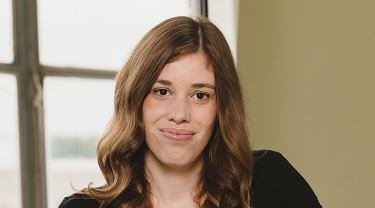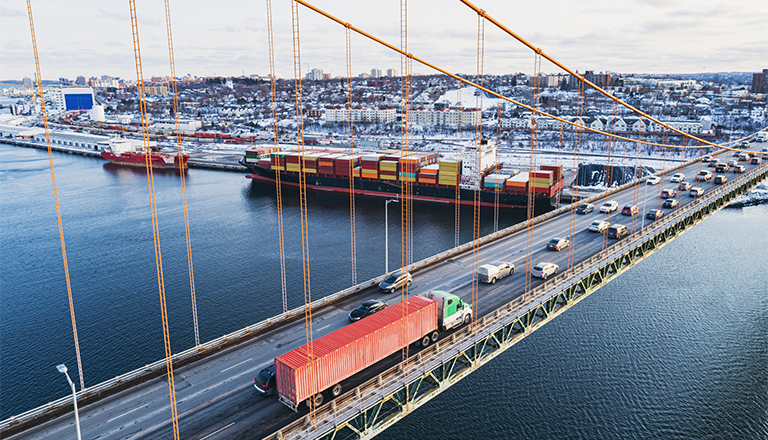After building and selling two successful businesses before the age of 30, Katherine Homuth decided to do the unthinkable: Revolutionize the hosiery industry by making fashion tights indestructible.
“Pantyhose is probably the last thing that I ever thought I would be getting into,” recalls the serial entrepreneur, who combined innovative technology and material science to invent comfortable, stretchy tights that are 10 times stronger than steel.
“My previous businesses had been in smart hardware and e-commerce software, and I realized that so many of the products that I was working on, while they would connect this and that to the internet, they often just seemed like technology for technology’s sake,” says the former owner of ShopLocket, an e-commerce site where startups could sell their products quickly and easily, and Female Funders, an online education platform for women investors.

In 2017, she launched SRTX, a Montreal-based company that makes Sheertex pantyhose from the world’s strongest polymers. Forget rips and runs after one or two wears. These ultra-resilient tights are bulletproof. Well, not exactly, but they’re made from the same durable fibres as bulletproof vests and heavy-duty climbing equipment.
They’re also the top selling brand in the United States, generating close to $50 million in revenue in 2023, up tenfold from $5 million in 2019.
The backstory
Katherine Homuth has always been a problem-solver, so finding a way to rid the world of poor quality, disposable nylons—even though the last innovation in hosiery was in the 1950s with the invention of spandex—didn’t deter her.
“I just couldn’t help, but think that we could take new technologies and apply it to the apparel category and not just create better consumer experiences, but hopefully, also take something that was such a disposable product and make it more sustainable,” says the savvy entrepreneur, who won the Governor General’s Innovation Award in 2020 and was named one Canada’s Top 100 Most Powerful Women.
“Since Day 1, creating long-lasting tights that result in less waste has been our North Star. We’re actively helping make fast fashion a thing of the past.”
You should also check out
Rapidly growing sector remains resilient despite turbulent headwinds
Exporting her revolutionary brand to the United States was always part of her game plan.
“We knew out of the gate that the U.S. was going to be our first market,” says Homuth, who targeted the U.S. because of its similarities to the Canadian market. It also helped that her company was backed by Y Combinator, a technology startup accelerator based in California.
She reasoned that if Sheertex could win over customers in the U.S., other global buyers would follow.
Initially launched as a direct-to-consumer company, its Sheertex premium pantyhose, which sell for $39 to $135 a pair, are now available in major retailers, including H&M and Costco, and exported to buyers in the European Union, United Kingdom and Australia.
Since 2017, SRTX’s staff has grown to more than 180 and two new products have been created:
- Watertex, a water-repellent knit poised to revolutionize the swimwear industry; and
- Cortex Software, a platform to automate manufacturing operations to reduce environmental impacts.
You should also check out
EDC Women in Trade guide offers insights to help Canadian women-owned businesses succeed internationally
Key challenges
“This was really a long road. The very first prototypes honestly looked more like cheesecloth than pantyhose. They were white, they didn’t stretch, they really just got hacked off the machine. We didn’t have the technology to assemble them properly,” she recalls.
There were also issues with the tights getting snagged on fingernails, uneven colouring and ill-fitting waistbands.
Since traditional machines couldn’t work with the strong knit, the company needed its own state-of-the-art manufacturing facility. But accessing the capital, especially during the global pandemic, to build a 300,000-square-foot facility in Montreal wasn’t going to be easy. That’s when Export Development Canada (EDC) was contacted for financial support.
In 2020, in collaboration with RBC, Homuth’s financial institution, EDC provided SRTX with an EDC Account Performance Security Guarantee (APSG), in support of bonding, which enabled the RBC to free up working capital for SRTX to expand its operations. When SRTX was ready to further expand the company’s new global headquarters, the same APSG was more than doubled.
You should also check out
Expand your understanding of the 11 universal trade terms used in global sales contracts and how they impact your business operations.
With a direct loan from EDC, SRTX was able to finance new equipment for its factory, where everything is done in-house—from producing the pantyhose to shipping them to global markets. “I’m sitting in the factory where almost all of the equipment has been financed by EDC,” Homuth said during our recent webinar, Kickstart 2024 by securing financing for global growth.
“With no external suppliers, emissions from transportation will be reduced, making SRTX a more sustainable company,” Homuth explains of the fully vertical business model. “That’s a huge lift, huge investment, but it’s something that we truly believe gives us a unique, differentiated edge in the apparel industry, but also just in the materials world.”
“I couldn’t be more grateful for the unparalleled support and guidance (EDC has) provided throughout SRTX’s growth journey,” says Homuth, a skilled angel investor who has raised more than $150 million in venture capital for her company. “Since their first investment, EDC has been a true partner.”
Katherine Homuth’s tips for entrepreneurs
Build a strong network: You don’t have to do it alone. “Surround yourself with other entrepreneurs, surround yourself with people who can help you laugh about it, and find ways to take care of yourself in the process,” says Homuth, who credits the Canadian Technology Accelerator program offered by the Trade Commissioner Service (TCS) for “the opportunity to interact with so many incredible entrepreneurs” and learn about the importance of venture capital for business growth.
Take advantage of government support: There are many resources, agencies and associations available to help Canadian businesses grow, innovate and expand internationally. Homuth is especially thankful for the knowledge and insights she’s received from the TCS and Innovation, Science and Economic Development Canada (ISED). “As we become a more industrial company, the government advice on how we actually move through some of the relationships and helping to connect us has been so helpful,” she says.
One of Homuth’s earliest venture capital investors came from the Business Development Bank of Canada (BDC) through their Women in Technology Venture Fund. As one of the world’s largest venture capital (VC) funds, it invests in women-led technology companies and helps build a robust ecosystem to support women in tech.
Be prepared to solve problems: Author of Funded, An Entrepreneur’s Guide to Raising your First Round, Homuth admits the life of an entrepreneur is difficult because you often wear multiple hats and face challenges every day. “You need to get really good at not freaking out every time something gets to you and be more like, ‘This is just another opportunity. This is what we do. This is what makes us different.’ ”
Tune into the EDC Export Impact Podcast on May 1 when Katherine Homuth shares her exporting journey with our host, Joe Mimran.









